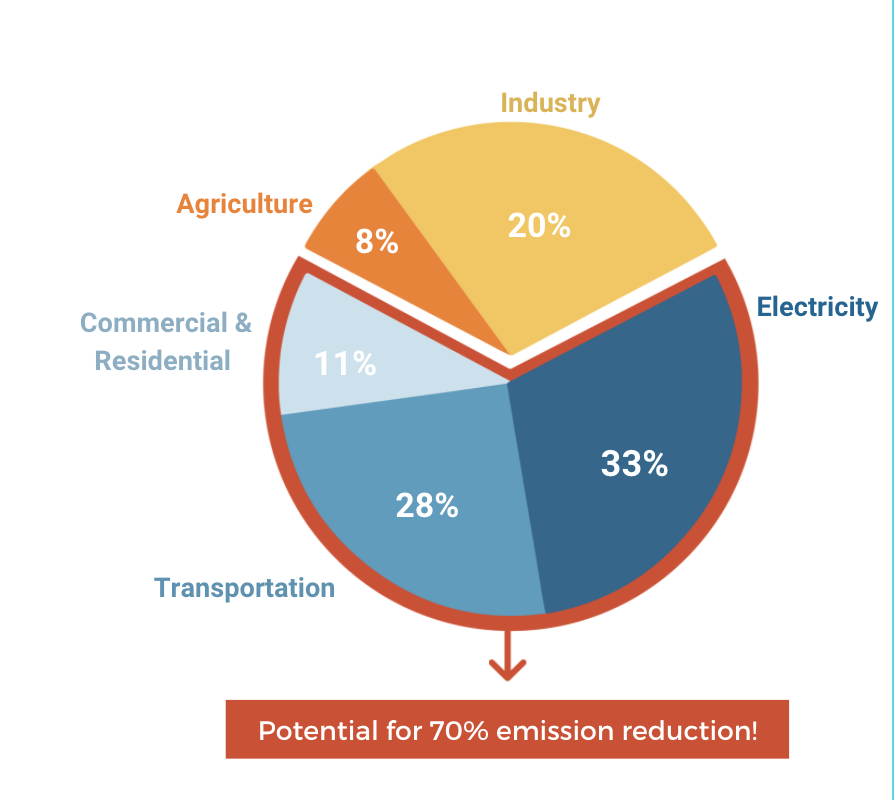Utah Clean Energy is known for our work expanding the use of renewable energy, and now we’re taking this work to the next level!
If tomorrow we woke to an energy grid suddenly powered by 100% clean electricity, we would only eliminate 33% of our nation’s greenhouse gas emissions. But when we transition our homes, buildings, and transportation to be powered by that clean electricity (electrification), we up the ante with the potential to eliminate over 70% of our nation’s greenhouse gas emissions!

Utah Clean Energy won’t settle for anything less, which is why we’re launching our “Beneficial Electrification” program dedicated to maximizing the benefits of clean energy by electrifying homes, buildings, and transportation. Heading up this ambitious new initiative is the newest member of our team, Thomas Kessinger!
Introducing Thomas Kessinger, Utah Clean Energy’s New Beneficial Electrification Program Manager

Thomas Kessinger is a clean energy attorney specializing in the complex intersection between energy, electricity, and sustainability. Through his work at the Western Electricity Coordinating Council, Thomas had a front-row seat in overseeing cutting-edge programs related to everything from cyber-security to the regionalization of the Western Interconnection.
Q&A
Q: What brought you to the Utah Clean Energy team?
A: I had a reckoning with the inversion at a young age. I remember driving up the canyon to go skiing with my dad, breaking through the inversion halfway up Big Cottonwood, and him saying how much worse it could get. Even then, I knew it had to change. I went to law school to bring about that change. Naturally, because bad air quality is tied to pollution, I gravitated toward Environmental Law, but it was Energy Law that shifted the focus of my career for good. The swiftest change would be through implementing progressive energy and electricity policies—moving toward nonpolluting energy resources like wind and solar clean our air, an elegant solution.
Q: Beneficial Electrification sounds eerily like other catch-all industry terms (smart grid sound familiar?). In layman’s terms, what exactly is Beneficial Electrification?
A: It’s two things: one side is “electrification” or electrifying all of the technologies that we use, which are currently powered by fossil fuels. Think of your range, oven, furnace, water heater, dryer, and vehicles being powered with electricity. Then you have the beneficial component – that is the tide that moves all of the ships. It is a catch-all term for the financial, health, and community benefits that come when we transition away from fossil fuels toward powering our electricity consumption with clean, climate-friendly, renewable energy sources. In addition to the outdoor local air quality improvements and larger climate benefits, electrifying our homes and buildings has the potential to bring important indoor air quality benefits to Utah families.
Q: What are the hurdles to Beneficial Electrification?
A: Consumer adoption remains one of the largest hurdles to the energy transition. We have the technology we need to enable it, but we need more people to adopt Beneficial Electrification technologies at a faster rate. Change is always a process and not an event. It is our job to continue steering the conversation towards Beneficial Electrification so people become comfortable with the technology and incorporating it into their lives.
Q: What are the solutions to those hurdles?
A: The great part about Beneficial Electrification is that everyone has an opportunity to contribute, and each step of the way is an opportunity to clean our air, support small businesses, and reduce the utility costs for all. Every gas appliance, including your furnace, water heater, range, and oven, will need to be replaced. We need teams of small businesses who can pick up that slack.
- As a consumer, you can choose to spend your money on an EV or heat pump for space and water heating.
- As an employee, you can encourage your offices to switch to electric fleets and to adopt electrified space and water heating.
- As a small business owner, you can capitalize on the consumer demand for these technologies.
- As an electricity customer, you can request more flexible policies from your utility such as time of use rates, or rebates for the installation of heat pumps.
Importantly, each of us in every capacity has an opportunity to take part in this transition. The more we electrify our world, the more health and economic benefits will result. It might seem counterintuitive, but as we electrify, the cost of our electricity is expected to decrease.
Q: That’s enough of the technical stuff. What do you do when you’re not working on Beneficial Electrification?
A: Working on the energy transition is inspiring. But sometimes you can feel the enormity of the challenge we face. So, when things can get discouraging, I make sure to balance my energy advocacy work with a healthy dose of nature and creativity.
As a Utahn, I feel a duty to go outside and explore. My favorite trail in the Wasatch Foothills is the Ferguson Canyon trail (and it’s dog friendly). In addition, I own and operate a non-commercial musician and artist incubator. I partner with artists to produce and record their material at no cost. This allows them to spend their hard earned money on self-care or try other creative promotion strategies. By partnering with an artist, we make sure our incentives are aligned to do the best work possible.






